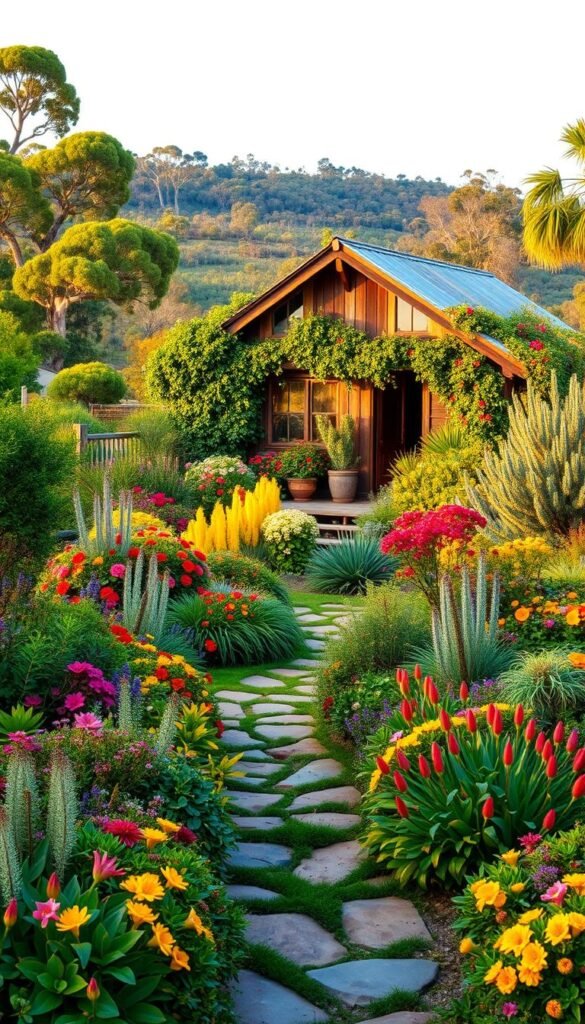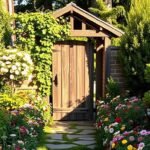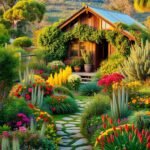Imagine stepping into a space where soft hues blend with textured foliage, creating a relaxed yet vibrant atmosphere. This is the magic of blending classic cottage charm with resilient flora that thrives in local conditions. By choosing species adapted to your region, you’ll craft a landscape that feels both timeless and uniquely suited to its environment.
Traditional designs often rely on water-intensive varieties, but there’s a smarter approach. Many drought-tolerant alternatives offer the same romantic appeal—think delicate blooms, layered heights, and seasonal interest—while supporting pollinators like butterflies and birds. These natural choices create habitats while reducing maintenance, letting you spend less time working and more time enjoying your sanctuary.
You’ll love how effortlessly these selections mirror the whimsical, free-spirited vibe of cottagecore aesthetic principles, but with a practical twist. Their extended flowering periods and adaptability mean your outdoor area stays lively through changing seasons. Plus, their deeper roots and natural resilience make them ideal for creating lush displays without constant care.
This approach isn’t just about beauty—it’s about building a sustainable retreat that honors your local ecosystem. Whether you’re drawn to muted pastels or subtle greenery, every plant plays a role in crafting that dreamy, informal look. Ready to reimagine what a cottage-inspired space can be?
Understanding the Australian Cottage Garden Aesthetic
Picture a landscape where every hue feels like it belongs, blending like watercolors on canvas. This style thrives on natural harmony, using plants that create visual poetry through thoughtful combinations. Let’s explore how to capture this magic in your own space.
The Charm of Soft Pastels and Textures
Delicate pinks, creamy whites, and muted lavenders form the heart of this look. Warm tones like coral and buttery yellow pop against cooler blues and silvery greens, creating depth. Many local species offer these hues naturally—think flowering grevilleas with blush-toned blooms or eremophilas sporting violet flowers.
Grey-green foliage acts as nature’s neutral, tying different elements together. Pair feathery grasses with broad-leafed shrubs to build texture. This contrast mimics the layered feel of traditional designs while staying drought-resistant.
Embracing an Informal, Layered Design
Forget rigid rows—this style celebrates joyful chaos. Let taller plants mingle with groundcovers, allowing shapes to overlap organically. Cluster flowering varieties in uneven groups, creating pockets of color that guide the eye.
Mix fine-textured grasses with velvety leaves for tactile interest. As seasons change, your space will evolve naturally, maintaining that cherished “lived-in” charm. Best part? These arrangements thrive with minimal pruning, letting nature take the lead.
Essential Elements of an Oz-Inspired Cottage Garden
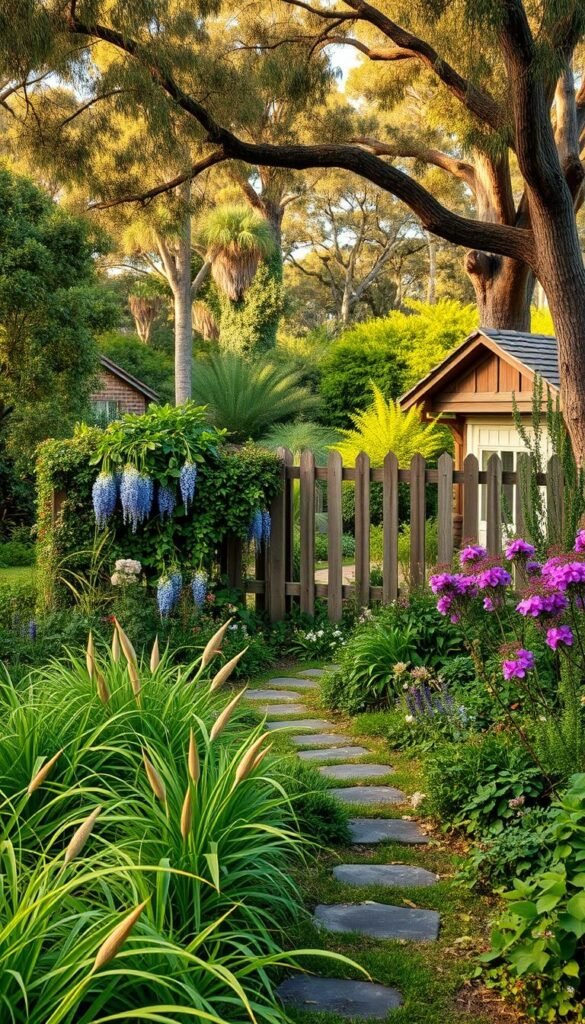
Consider transforming your yard into a lush retreat that mimics nature’s untamed beauty. The secret lies in balancing free-form growth with intentional design choices that feel both effortless and inviting. Let’s explore how to cultivate that coveted wild-yet-tamed aesthetic.
Creating a Lush, Overgrown Feel
Start by choosing compact shrubs with rounded forms and delicate blooms. Varieties like dwarf waxflower or pink correa offer soft shapes and pastel tones that naturally build coziness. Cluster three to five of the same species together, letting their foliage overlap like puzzle pieces.
Throw spacing guidelines out the window—crowding is your friend here. Planting closer than recommended encourages that joyfully tangled look seen in thriving bushland. You’ll need to trim occasionally for pathways, but avoid over-pruning. A little chaos adds character!
Mix textures freely: feathery grasses beside broad-leafed groundcovers create visual depth. This approach mirrors how australian natives grow in the wild, forming layered communities. Your space will evolve seasonally, maintaining that fresh, lived-in charm everyone loves.
Remember, the goal isn’t perfection. Let plants spill over borders and self-seed in unexpected places. This relaxed style celebrates nature’s spontaneity while creating habitats for local wildlife. Before long, your native garden will feel like it’s always belonged there.
Selecting Native Plants and Groundcovers for Vibrant Layers
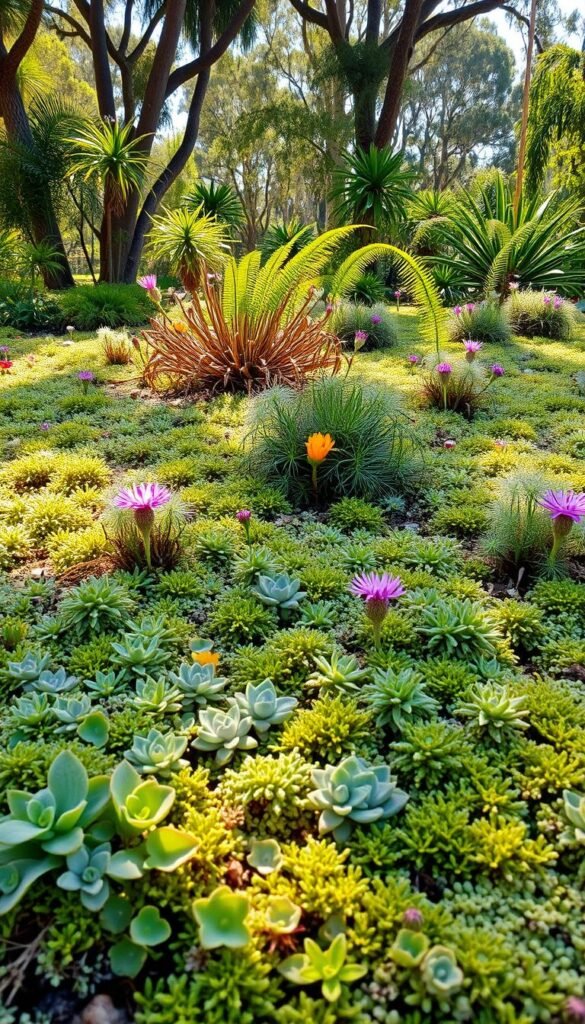
Think of your garden as a living tapestry where textures and tones weave together through smart plant pairings. The right combinations transform flat spaces into dynamic displays that shift with the seasons.
Popular Groundcover Choices
Swan River daisy blankets the earth in a confetti of white and pink blooms from spring through autumn. Paired with boobialla’s mauve flowers, these low-growing varieties form dense mats that suppress weeds. Their drought tolerance means you’ll water less while enjoying constant color.
Struggling with shady corners? Native violets thrive where sunlight struggles to reach, offering delicate green-and-white patterns under trees. For sunny slopes, try fan flower’s purple blossoms cascading like living waterfalls. Happy wanderer adds vertical interest with lilac blooms scrambling over rocks or fences.
Foliage Accents and Color Contrasts
Silver-leaved coastal rosemary acts as nature’s neutral, making pastel flowers pop. “Foliage is the secret sauce,” says landscape designer Mara Ripani. “It creates continuity between seasonal shows.”
Mix blue-grey leaves with golden blooms for striking contrast. These structural elements maintain visual appeal when flowering slows. Rambling groundcovers knit everything together, their stems weaving through beds like green thread.
By layering textures and strategic color placements, you’ll craft depth that feels both wild and intentional. Your space becomes a habitat that delights the eye while supporting local ecosystems.
Australian Cottage Garden: Native Plant Selections for an Oz-Inspired Look
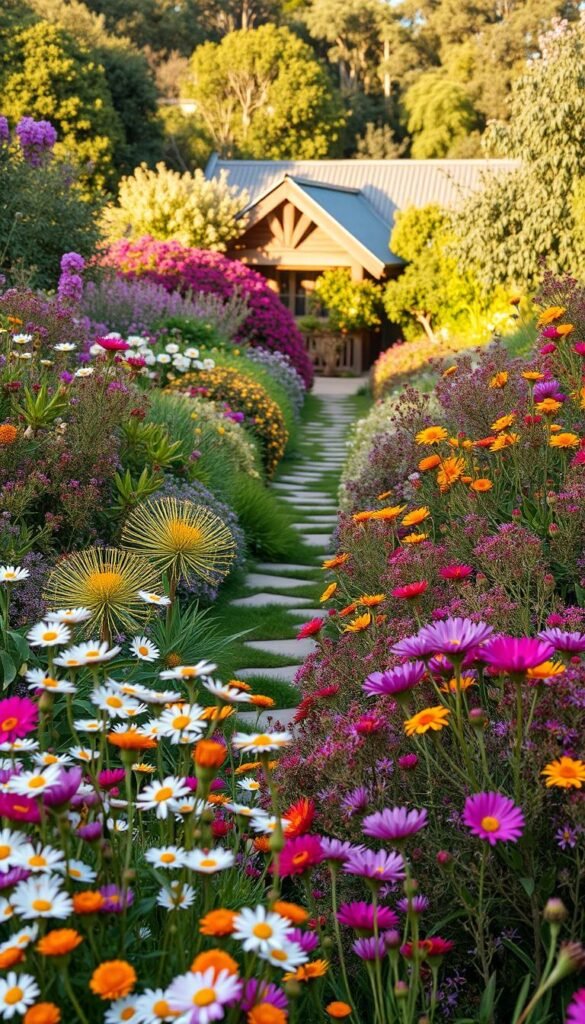
Creating a harmonious outdoor space starts with thoughtful pairings of texture and color. While bold blooms catch the eye, subtle combinations of foliage and delicate flowers build depth that lasts through seasons.
Expert Tips for Pairing Textures and Tones
Choose blossoms in soft hues like pale pinks and creamy yellows instead of neon brights. Smaller flowers, like those on fan flower or everlasting daisy, attract more bees while blending seamlessly. This approach creates visual calmness that feels naturally wild.
| Plant Type | Flower Size | Color Palette | Texture |
|---|---|---|---|
| Trailing Groundcover | Small | Lavender, White | Feathery |
| Bushy Shrub | Medium | Blush, Cream | Velvety |
| Clumping Perennial | Tiny | Buttercup, Sage | Grassy |
Pair plants with neighboring colors on the wheel—mauve beside blue-grey leaves creates quiet elegance. Save bold contrasts for special moments: a cluster of deep red blooms against silver foliage makes a striking centerpiece.
Mix textures as carefully as colors. Combine wispy grasses with rubbery succulents or fuzzy leaves with glossy stems. These combinations catch sunlight differently, adding movement without clutter.
Remember, restraint leads to magic. Let three harmonious tones dominate, using one accent shade sparingly. Your space will feel cohesive yet full of delightful surprises.
Embracing Australian Grasses and Kangaroo Paws in Your Garden
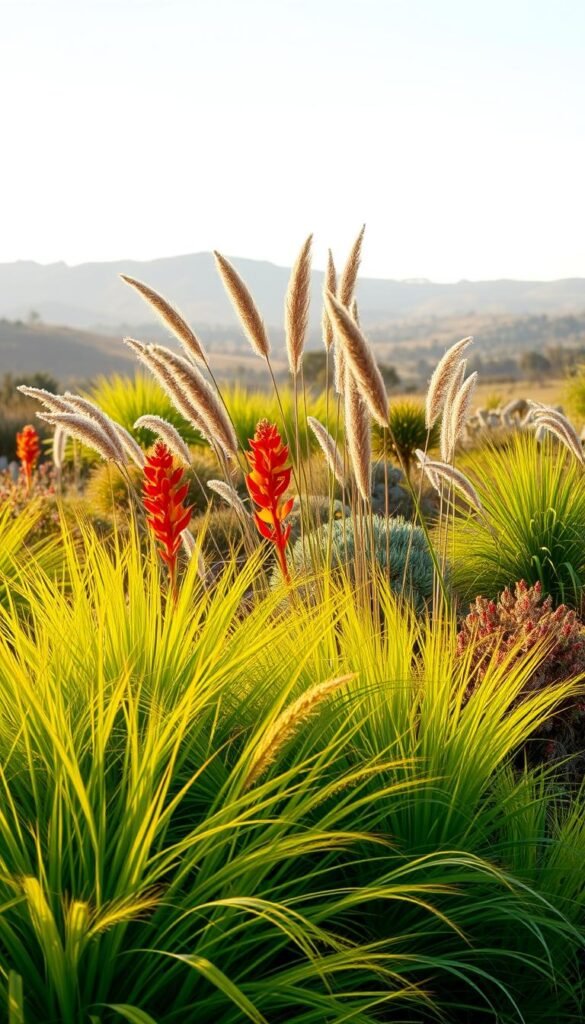
Transform your outdoor space with movement and color using nature’s most dynamic performers. Grasses sway like living sculptures while bold blooms add fiery punctuation—together they create rhythm that changes with every breeze.
Integrating Ornamental Grasses
Cluster knobby club rush in uneven groups of three to five plants. This mimics how grasses grow wild, creating natural focal points. For tricky spots like rock edges, mat rushes thrive with neglect while keeping their evergreen charm year-round.
Kangaroo Paws: A Touch of Down Under
These fuzzy-flowered stars steal the show each spring. Dwarf varieties shine in container arrangements or casual borders. Want drama? Mass plant tall types like Big Red—their scarlet spikes become living fireworks against softer foliage.
Surprisingly adaptable, kangaroo paws pair beautifully with roses or lavender. Their tubular flowers become hummingbird cafés while requiring minimal water. Just give them well-drained soil and full sun, then watch your garden come alive with Aussie spirit.
Pastel Flowering Shrubs and Climbers for a Soft, Inviting Ambience
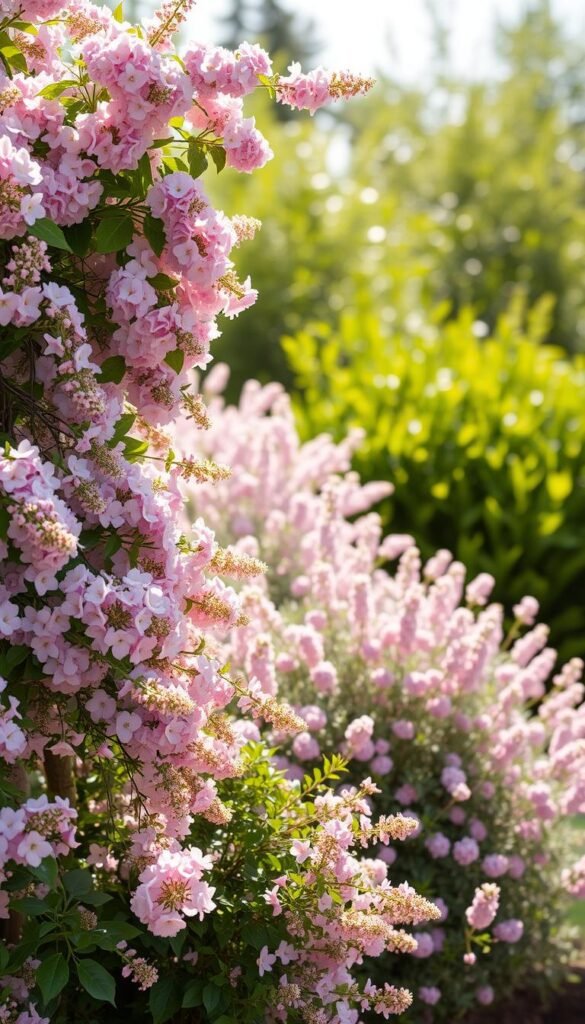
Envision a serene retreat where delicate blooms cascade over fences and spill from borders in whispers of color. The secret lies in choosing plants that layer soft tones like watercolor strokes, creating depth without overwhelming the senses.
Curating a Palette of Gentle Hues
Start with Geraldton wax, a drought-tolerant star that showers your space with pink flowers from late winter through spring. Its wispy branches thrive in full sun, extending your seasonal show when other plants rest. Pair it with tea trees—their fine leaves and profuse white flowers create airy backdrops for bolder blooms.
Coastal rosemary works double duty, offering silver-gray foliage and nearly year-round purple flowers in muted lilac tones. “These subtle performers knit designs together,” says floral designer Lila Chen. “They’re the quiet heroes of nuanced landscapes.”
For vertical drama, train bower of beauty climbers. Their trumpet-shaped red flowers peek through pergolas, offering a native alternative to roses. Below, correasfit shrubs add charm with bell-shaped blossoms in blush and cream. Together, these plants create shifting waves of color that transition seamlessly from winter spring into summer.
Remember: restraint amplifies impact. Let three harmonious hues dominate—maybe soft pinks, pale lavenders, and creamy whites—with occasional ruby accents. Your space will feel cohesive yet endlessly fascinating as each plant takes its seasonal turn in the spotlight.
Designing the Layout: Meandering Paths and Informal Borders
Let your outdoor space tell its own story through curves that invite curiosity. Winding walkways framed by billowing shrubs encourage exploration, while uneven edges blur the line between cultivated beds and wild beauty. This approach feels welcoming rather than rigid, perfect for small gardens seeking depth.
Cultivating Natural Patches and Groupings
Cluster flowering plants in irregular drifts, mimicking how they grow in meadows. Leave breathing room between clusters—this contrast makes each group feel intentional. Scatter self-seeding varieties along pathways to create spontaneous pops of color that change yearly.
For borders, let groundcovers spill over edges like living lace. A mix of textures softens hardscapes while attracting pollinators. Remember: blending structure with wild growth keeps designs grounded yet dynamic.
Your cottage garden becomes a sanctuary when layouts flow organically. Focus on creating moments of discovery—a bench nestled among grasses or a stone path disappearing behind shrubs. These touches make every stroll feel like uncovering hidden treasures.

